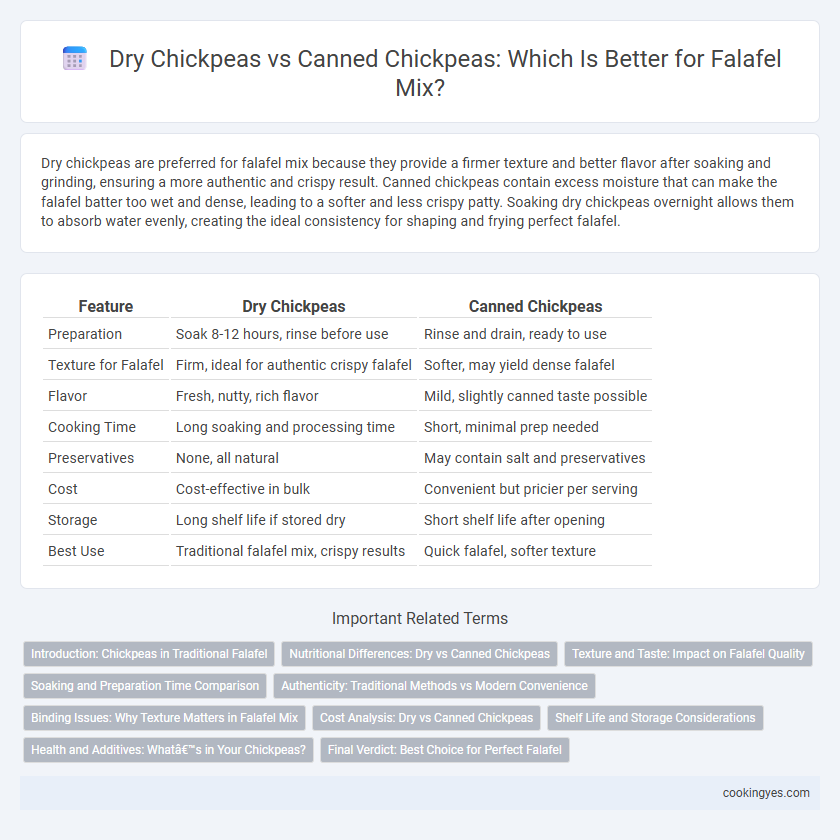Dry chickpeas are preferred for falafel mix because they provide a firmer texture and better flavor after soaking and grinding, ensuring a more authentic and crispy result. Canned chickpeas contain excess moisture that can make the falafel batter too wet and dense, leading to a softer and less crispy patty. Soaking dry chickpeas overnight allows them to absorb water evenly, creating the ideal consistency for shaping and frying perfect falafel.
Table of Comparison
| Feature | Dry Chickpeas | Canned Chickpeas |
|---|---|---|
| Preparation | Soak 8-12 hours, rinse before use | Rinse and drain, ready to use |
| Texture for Falafel | Firm, ideal for authentic crispy falafel | Softer, may yield dense falafel |
| Flavor | Fresh, nutty, rich flavor | Mild, slightly canned taste possible |
| Cooking Time | Long soaking and processing time | Short, minimal prep needed |
| Preservatives | None, all natural | May contain salt and preservatives |
| Cost | Cost-effective in bulk | Convenient but pricier per serving |
| Storage | Long shelf life if stored dry | Short shelf life after opening |
| Best Use | Traditional falafel mix, crispy results | Quick falafel, softer texture |
Introduction: Chickpeas in Traditional Falafel
Traditional falafel relies heavily on chickpeas, with dry chickpeas preferred for their superior texture and flavor after soaking and blending. Dry chickpeas create a firmer, less mushy falafel with a crisp exterior, while canned chickpeas often result in a softer mix due to higher moisture content. Using dry chickpeas also allows for better control over the seasoning and consistency of the falafel mix, preserving authenticity in this Middle Eastern staple.
Nutritional Differences: Dry vs Canned Chickpeas
Dry chickpeas generally contain higher protein and fiber levels compared to canned chickpeas, which often lose some nutrients during processing. Canned chickpeas typically have added sodium and preservatives that can affect their nutritional profile. For a healthier falafel mix, using dry chickpeas allows better control over seasoning and preserves more natural nutrients.
Texture and Taste: Impact on Falafel Quality
Dry chickpeas soaked overnight develop a firmer texture that results in a crispier, more authentic falafel crust, enhancing overall mouthfeel and flavor complexity. Canned chickpeas, being softer and moister, produce a denser falafel with a less distinct texture and slightly muted taste. Optimal falafel quality depends on the drier consistency of soaked chickpeas to achieve the traditional balance of crunch and tender interior.
Soaking and Preparation Time Comparison
Dry chickpeas require at least 8 to 12 hours of soaking to rehydrate properly, resulting in a firmer texture ideal for authentic, crispy falafel. Canned chickpeas offer convenience by eliminating soaking time but tend to produce a softer mixture that can affect the falafel's structure and crispiness. Soaking dry chickpeas not only improves texture but also enhances flavor, making it the preferred choice for traditional falafel preparation.
Authenticity: Traditional Methods vs Modern Convenience
Dry chickpeas preserve the authentic texture and flavor essential for traditional falafel, as soaking and grinding them fresh maintains their natural nuttiness and firmness. Canned chickpeas offer modern convenience but often result in a softer, less textured falafel that deviates from the classic Middle Eastern recipe. Using dry chickpeas is preferred by purists seeking to replicate the genuine crispy exterior and tender interior characteristic of authentic falafel.
Binding Issues: Why Texture Matters in Falafel Mix
Dry chickpeas provide a superior texture for falafel mix due to their ability to absorb water evenly, creating a firmer and more cohesive binding that prevents the falafel from falling apart during frying. Canned chickpeas, often softer and wetter, release excess moisture that weakens the binding capacity, resulting in a crumbly and less stable falafel structure. Optimal falafel texture relies on using soaked dry chickpeas, which enhance the mixture's integrity and ensure a crisp exterior with a tender, well-bound interior.
Cost Analysis: Dry vs Canned Chickpeas
Dry chickpeas offer a significantly lower cost per pound compared to canned chickpeas, making them more economical for large batch falafel preparation. Although canned chickpeas provide convenience by reducing soaking and cooking time, their higher price per serving can impact overall budget efficiency. Bulk purchasing and home soaking of dry chickpeas maximize cost savings without compromising falafel texture or flavor.
Shelf Life and Storage Considerations
Dry chickpeas offer a significantly longer shelf life, typically lasting up to two years when stored in a cool, dry place, making them ideal for long-term storage in falafel mix preparation. Canned chickpeas, while convenient and ready-to-use, have a shorter shelf life of about two to five years unopened, but once opened, they require refrigeration and should be consumed within three to four days to maintain freshness and prevent spoilage. Proper storage of dry chickpeas in airtight containers preserves their quality, whereas canned chickpeas necessitate attention to expiration dates and prompt refrigeration after opening to ensure optimal falafel texture and flavor.
Health and Additives: What’s in Your Chickpeas?
Dry chickpeas offer a healthier option for falafel mixes due to the absence of preservatives and additives commonly found in canned chickpeas, ensuring a cleaner, more natural ingredient profile. Canned chickpeas often contain added sodium and stabilizers, which can affect both the nutritional value and taste of the falafel. Choosing dry chickpeas allows for full control over soaking and cooking processes, reducing unwanted chemicals and preserving essential nutrients like fiber and protein.
Final Verdict: Best Choice for Perfect Falafel
Dry chickpeas yield a superior falafel texture with a firmer, fluffier interior and crispier exterior due to proper soaking and grinding, essential for authentic Middle Eastern recipes. Canned chickpeas offer convenience but tend to produce a denser, wetter mix, often requiring additional flour or breadcrumbs to bind. For perfect falafel, dry chickpeas are the best choice, delivering the ideal balance of moisture and structural integrity that creates crispy, flavorful falafel balls.
Dry Chickpeas vs Canned Chickpeas for Falafel mix Infographic

 cookingyes.com
cookingyes.com